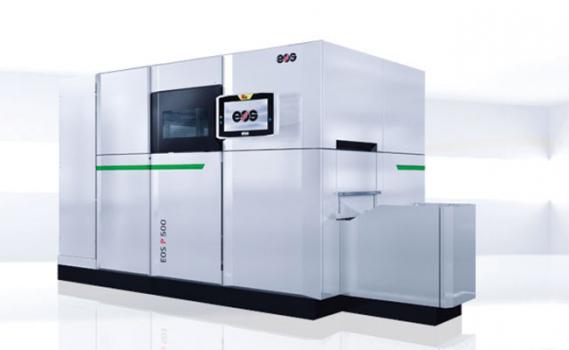3D Printer Processes Polymer Materials
Description
The latest system for additive manufacturing is the EOS P 500. The system offers high efficiency for lowest cost-per-part, comes automation ready and can process polymer materials, which require operating temperatures of up to 300°C.
The EOS P 500 builds twice as quickly as the current fastest laser sintering machine (EOS P 396) thanks to a dual-laser system fusing the powder, and a new re-coater. The latter applies a new layer of powder to the building platform with high speed (600 mm/s) and maximum adjustability. Also, the material flow has been optimized. In contrast to previous systems, the EOS P 500 preheats polymer material in advance, before it is applied on the build platform, reducing layer times. The system can also reuse all recycled powder for the next build job at higher fill rates, further increasing the efficiency of the system.
The steps before and after the actual build process are streamlined substantially: Pre-heating of the exchangeable frame and cool-down of the used exchangeable frame (containing the manufactured part) take place outside of the EOS P 500. Additionally, switching between the exchangeable frames is extremely short – within 15 minutes after a build job is completed, a new manufacturing process can be started. In combination with rarely needed cleaning (typically 1x per week) and maintenance (typically 1x per year), the total cycle times of the EOS P 500 are improved significantly by up to 75% compared to the EOS P 396 – giving businesses a system with maximized machine uptime.
The high productivity comes with the known EOS premium part quality. The EOSAME feature homogenizes the energy input of the laser, thus ensuring high quality and reproducible part properties and dimensional accuracy across the complete build volume – key for serial production.
The EOS P 500 comes alongside several solutions for monitoring and integration. The system offers industrial quality assurance through sensory, as well as camera based (optical and thermal), data evaluation, for example stating residual oxygen levels or the temperature of the build chamber. In conjunction with EOSCONNECT software, machine and production data can be gathered and made available in real-time. EOS also offers an intuitive app to visualize the data on a dashboard. This is the next step towards comprehensive and user-friendly machine park surveillance.
Software integration also plays an important role for preparing the AM build job. The EOS P 500 is the first EOS system for additive manufacturing with polymers that is supported by the intuitive, open and productive CAM tool EOSPRINT 2 – a software that already successfully supports a large number of EOS metal systems. The software enables engineers to assign and to optimize build parameters for their CAD data.
This industrial grade connectivity before, during and after the AM build process is key to embed the EOS P 500 into an automated manufacturing environment and the first step towards automatized polymer production chains.
Users can process materials up to 300°C with the EOS P 500 – making it possible to manufacture polymer material classes such as PA6, PBT, PET, PPS, PEKK and others. A three stage filter-unit – consisting of a cooling trap, fines filter and reactive coal filter – counters material outgassing and particle contamination, contributing to a high quality of the AM build process. Being able to manufacture high performance polymer materials opens up new application areas where businesses can benefit from industrial 3D printing – for example in the mobility and automotive sector or when manufacturing electronic components.
The first high performance polymer available for the EOS P 500 will be PEKK, a material known for its high thermal stability, inherent flame retardancy and high chemical resistance, makes it a lightweight alternative to metal. The goal is to release a high performance material at a competitive cost-per-part, enabling industrial applications not feasible until now. EOS recently signed a joint development agreement with Arkema, a leading global manufacturer in specialty chemicals and advanced materials, to develop an EOS material based on the KEPSTAN PEKK product line of Arkema. As the EOS system is an open platform, other companies can develop materials for the EOS P 500 too. Today, EOS also cooperates with Evonik and BASF for developing future polymer materials.
Specs
EOS P 500 | |||
Building volume | 500 x 330 x 400 mm (19.7 x 13 x 15.7 in) | ||
Building rate | up to 40 mm/h (1.6 in/h); up to 6.6l/h | ||
Layer thickness (depending on material) | 0.06 mm (0.00236 in), 0.10 mm (0.00394 in), 0.12 mm (0.00472 in), 0.15 mm (0.00591 in), 0.18 mm (0.00709 in) | ||
Laser type | CO2, 2 x 70 W | ||
Precision optics | F-theta lens, surface module, high-speed scanner | ||
Scan speed during building process | up to 2 x 10 m/sec (32.8 ft/sec) | ||
Power supply | 400 V/100 A; max. power consumption 80 A | ||
Dimensions (W x D x H) | |||
System | 3,400 x 2,100 x 2,100 mm (133.9 x 82.7 x 82.7 in) | ||
Recommended installation space | min. 7.2 x 5.2 x 3 m (284 x 205 x 118 in) | ||
Weight | approx. 7,000 kg (15,432 lb) | ||
Software | |||
| EOSYSTEM with EOSAME feature, EOSPRINT 2 with SmartScaling feature and EOS ParameterEditor, EOSCONNECT, EOSTATE Powderbed | |||

